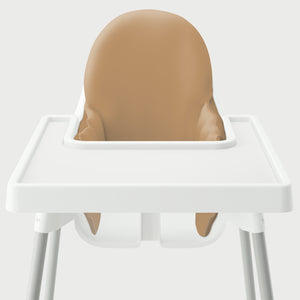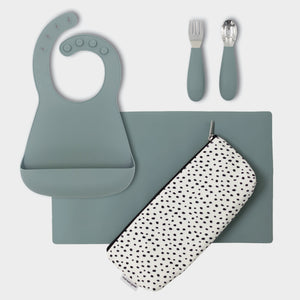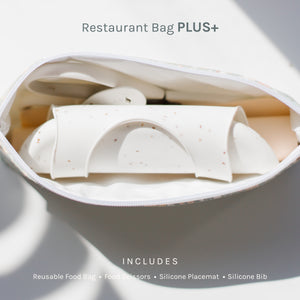Set Your Baby Up for Success with Solids by Reading Their Feeding Cues
How to Read Your Baby's Cues
It's no secret that it can be hard and sometimes frustrating to read baby cues and figure out what your baby wants or needs. Crying is the most clear signal that a baby needs something, but it isn't always a baby's only way to communicate that they are hungry. There are some other active cues that a baby may use to signal that they want to eat. Babies will use body language to tell you what they want. If you can read your baby's early signs of hunger before they use late feeding cues like crying, you might save yourself some frustration.
Why Baby Hunger Cues are Important
Learning to read your baby's hunger cues can help you understand what your baby needs. It can also help you avoid frustration and have an easier feeding time. Understanding your baby's specific signs of hunger can help you develop healthy feeding habits and help build your bond with your baby. The American Academy of Pediatrics states that responsive feeding helps babies learn to regulate their food intake. Read on for signs of hunger and satiety to help you better understand your baby.

What are Babies' Feeding Cues?
Your baby will communicate in new ways as they grow. When your baby is a newborn and an early infant, they will use a subtle set of cues through body signals and physical movements to show you that they are hungry. These are some early cues your baby might use to signal hunger:
- Turning head towards anything that touches their face, rooting
- Putting hands in their mouth, sucking on hands
- Clenched fists
- Making sucking motions or lip smacking
- Becoming more alert
How Baby Hunger Cues Change With Age
As a baby grows and begins getting ready to eat solid foods, they may show you that they are ready to eat in new ways. Here are some signs your baby may be ready to begin eating solids:
- Baby has head control
- Baby doesn't need help to sit up
- Baby reaches for objects to put to their mouth while sitting
- Baby opens their mouth and leans to reach for offered food
- Baby makes sounds to indicate wanting to eat more
Your baby's hunger cues will change as they develop and learn how to eat solids. Babies may continue with signs they used as newborns, like lip smacking, or turning their heads towards food. They will also start to show interest and excitement when they see food. They may reach for and point at food you are holding. These non-verbal, body language cues help parents know when babies might be ready to try solid foods.

How to Read Your Baby's Fullness Cues
Learning to tell when your baby is full is important, too. This helps keep mealtime an enjoyable time for you and your baby.
When you first start offering solid foods, your baby might do more exploring and playing with food than actually eating it. This is part of the developmental process of learning what food is and how to eat it. If your baby does not seem interested in solid foods, it does not always mean they are not hungry. Your baby might still be hungry for milk or formula.
Understanding your baby's cues will help give you peace of mind that your baby has had their fill, help you figure out a feeding frequency that works for your baby, and also help you not overfeed your baby. Growth spurts are a healthy part of development, so you may need to change your feeding approach over time.
Signs that Your Baby is Eating Enough
Some signs that your baby is full:
- Baby pushes food away
- Baby plays with food more than eating
- Baby closes their mouth or turns their face away from offered food
- Baby makes noises to indicate they don't want to eat more
- Burping
- Becoming sleepy
- Baby takes longer pauses between bites
As your baby grows and becomes a toddler, it is helpful to offer snacks and meals on a feeding schedule instead of feeding on demand. Meals should be balanced and filling, including fruits and vegetables (Strong4Life n.d.). Babies and toddlers have smaller stomachs than adults, and need to eat more often. Once you are feeding solids to your baby, The Centers for Disease Control and Prevention recommends offering your child food every two to three hours (Centers for Disease Control and Prevention 2025). You should offer a mix of meals and snacks.
Toddlers may not know when to stop playing to eat, because they are still learning what hunger cues feel like in their bodies. As well as keeping a meal schedule, it is important to teach your toddler what hunger feels like. This will help avoid feelings of irritability. Still, it's normal for a toddler to miss their own hunger cues. This is why it is helpful to have a feeding schedule for your child. It takes time to develop a schedule of snacks and meals, and healthy feeding patterns.
Though hard to understand at times, baby cues offer clues to hunger and fullness. Parents and caregivers can learn to recognize baby hunger cues. This helps them give their babies a good feeding experience. It also helps them bond with their babies as they learn to eat solid foods. Responsive feeding helps babies develop strong attachment, according to the American Psychological Association. Strong attachment helps children interact with the world in a healthy way (American Psychological Association 2023). Understanding your baby's cues will have lasting impact on your child's life.
When to Seek Help From a Pediatrician
Your pediatrician is a great resource on infant development. Remember that all babies are different. This is not a comprehensive guide on hunger, feeding and baby cues. If you have any questions or concerns about your baby's eating or understanding your baby's feeding cues, talk with your doctor.
Sources:
"How Much and How Often To Feed." Centers for Disease Control and Prevention, March 11, 2025. https://www.cdc.gov/infant-toddler-nutrition/foods-and-drinks/how-much-and-how-often-to-feed.html
"Infant Food and Feeding." American Academy of Pediatrics, November 28, 2023. https://www.aap.org/en/patient-care/healthy-active-living-for-families/infant-food-and-feeding/?srsltid=AfmBOoqBq9jjwb8Gl0_co4mUaAh1JQ1CAOzEz_mvnDLT8-be8qNH5RWf
Jordan, Candina. “How to Tell When Your Baby Wants to Eat.” WebMD, February 20, 2024. https://www.webmd.com/parenting/baby/what-are-signs-baby-is-hungry.
Jordan, Mike M.D., F.A.A.P.S. "Infant Hunger Cues: Recognizing Early Signs Your Baby Needs to Feed." East Lake Pediatrics, March 16, 2025. https://www.eastlakepediatrics.com/infant-hunger-cues/
"Parents and caregivers are essential to children’s healthy development." American Psychological Association, last reviewed August 2, 2023. https://www.apa.org/topics/families/parents-caregivers-kids-healthy-development
“Signs Your Child Is Hungry or Full.” Centers for Disease Control and Prevention, October 21, 2024. https://www.cdc.gov/infant-toddler-nutrition/mealtime/signs-your-child-is-hungry-or-full.html.
"5 Signs Your Toddler Is Hungry." Strong 4 Life, Childen's Healthcare of Atlanta, Accessed October 7, 2025. https://www.strong4life.com/en/feeding-and-nutrition/hunger-and-fullness-cues/5-signs-your-toddler-is-hungry#:~:text=Toddlers%20are%20born%20with%20natural%20hunger%20and,feels%20when%20it%20is%20empty%20and%20full









